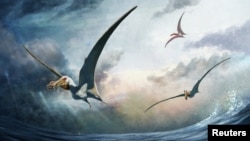Millions of years ago, a huge and powerful hunter flew in the skies above a former sea in what is now Australia. Its large mouth and long, pointed teeth captured fish and other sea life.
Scientists in Australia recently announced the discovery of fossil remains of the animal, named Haliskia peterseni. They said the fossils are the most complete remains of any pterosaur ever unearthed in Australia. The creature lived alongside dinosaurs during the Cretaceous Period, the researchers said.
Haliskia means "sea phantom." The researchers said Haliskia’s wings measured 4.6 meters across from end to end. The animal lived about 100 million years ago.
"The Eromanga Sea was a massive inland sea covering large parts of Australia when this pterosaur was alive," said Adele Pentland, a doctoral student in paleontology at Curtin University in Australia. Pentland was the lead writer of a study, which appeared recently in the publication Scientific Reports.
The thin bones of pterosaurs do not easily turn into fossils. For Haliskia, only 22 percent of the skeleton was unearthed. The bones included complete lower jaws, part of the upper jaw, throat bones, 43 teeth, vertebrae, ribs, bones from both wings and part of one leg.
Pentland said the researchers believe the muscle in the animal’s mouth, called the tongue, was very strong, based on the length of its throat bones.
"In many other pterosaurs, the throat bones are 30 percent or 60 percent the length of the lower jaw, whereas in Haliskia the throat bones are 70 percent the length of the lower jaw,” Pentland said.
Haliskia is a little larger and older, by about 5 million years, than the closely related Australian pterosaur Ferrodraco. Scientists announced its discovery in 2019. Haliskia's remains are more complete than those of Ferrodraco.
Both animals belong to a pterosaur group called anhanguerians known from remains found in China, the United States, Brazil, Britain, Spain and Morocco. The three other named Australian pterosaurs are known only from partial jaw bones, Pentland said.
The Haliskia individual's body ended up buried under sediment at the bottom of the Eromanga Sea.
Pterosaurs were the first of three vertebrate groups to fly, appearing about 230 million years ago. Birds appeared about 150 million years ago and bats appeared around 50 million years ago.
Pentland said the Haliskia discovery is also important because for many years experts believed Australia had very few fossils from the age of dinosaurs.
I’m Caty Weaver.
Will Dunham reported this story for Reuters. Caty Weaver adapted it for VOA Learning English.
________________________________________________
Words in This Story
fossil –n. the mineralized remains of an animal or plant that died long ago
pterosaur –n. a kind of ancient reptile that had wings and is believed to have been able to fly
paleontology –n. the study of ancient fossils and life
vertebrae –n. individual bones that form a backbone
rib –n. one of a group of bones that form the middle part of the body in many animals
sediment –n. very fine pieces of rock that settle to the bottom of water that, over time, form a solid level of rock
We want to hear from you. Our comment policy is here.










Forum